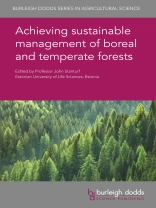- Focuses on advances in understanding forest ecophysiology which underpin good management, including mechanisms of root and canopy development.
- Explores the key challenges in ensuring forest management is consistent with forest ecosystem services, particularly managing the transition from monocultures to complex stands
- Highlights ways of diversifying forest products, including novel uses of timber, biomass, non-timber products and recreational services.
Daftar Isi
1.The scope and challenge of sustainable forestry: Philip J. Burton, University of Northern British Columbia, Canada;
Part 1 Tree physiology
2.Advances in understanding root development in forest trees: Donato Chiatante and Mattia Terzaghi, University of Insubria, Italy; Gabriella Stefania Scippa, University of Molise, Italy; and Antonio Montagnoli, University of Insubria, Italy;
3.Advances in understanding canopy development in forest trees: W. Keith Moser, USDA Forest Service, USA; Adam P. Coble, Oregon Department of Forestry, USA; Lea Hallik, University of Tartu, Estonia; Andrew D. Richardson, Northern Arizona University, USA; Jan Pisek and Kairi Adamson, University of Tartu, Estonia; Russell T. Graham, USDA Forest Service, USA; and Cynthia F. Moser, LLC Flagstaff, USA;
4.The response of forest trees to abiotic stress: Tanja G. M. Sanders, Thünen Institute of Forest Ecosystems, Germany; Peter Spathelf, University of Sustainable Development, Germany; and Andreas Bolte, Thünen Institute of Forest Ecosystems, Germany;
Part 2 Forest ecosystem services and climate change
5.Advances in understanding the role of forests in the carbon cycle: Matthew J. Mc Grath and Anne Sofie Lansø, Laboratoire des sciences du climat et de l’environnement, France; Guillaume Marie, Vrije Universiteit Amsterdam, The Netherlands; Yi-Ying Chen, Academia Sinica, Taiwan; Tuomo Kalliokoski, University of Helsinki, Finland; Sebastiaan Luyssaert and Kim Naudts, Vrije Universiteit Amsterdam, The Netherlands; Philippe Peylin, Laboratoire des sciences du climat et de l’environnement, France; and Aude Valade, Ecological and Forestry Applications Research Centre, Spain;
6.Trade-offs between management and conservation for the provision of ecosystem services in the southern Patagonian forests: Yamina Micaela Rosas, Laboratorio de Recursos Agroforestales, Centro Austral de Investigaciones Científicas (CADIC), Consejo Nacional de Investigaciones Científicas y Técnicas (CONICET), Argentina; Pablo Luis Peri and Héctor Bahamonde, Instituto Nacional de Tecnología Agropecuaria (INTA), Universidad Nacional de la Patagonia Austral (UNPA), Consejo Nacional de Investigaciones Científicas y Técnicas (CONICET), Argentina; Juan Manuel Cellini and Marcelo Daniel Barrera, Universidad Nacional de la Plata (UNLP), Argentina; and Alejandro Huertas Herrera, María Vanessa Lencinas and Guillermo Martínez Pastur, Laboratorio de Recursos Agroforestales, Centro Austral de Investigaciones Científicas (CADIC), Consejo Nacional de Investigaciones Científicas y Técnicas (CONICET), Argentina;
7.Advances in understanding forest ecosystem services: conserving biodiversity: Anne Oxbrough, Edge Hill University, UK; and Jaime Pinzón, Natural Resources Canada, Canada;
8.The impact of climate change on forest systems in the northern United States: projections and implications for forest management: W. Keith Moser, USDA Forest Service, USA; Patricia Butler-Leopold, Michigan Technological University and Northern Institute of Applied Climate Science (NIACS), USA; Constance Hausman, Cleveland Metroparks, USA; Louis Iverson, USDA Forest Service and Northern Institute of Applied Climate Science (NIACS), USA; Todd Ontl, Michigan Technological University and Northern Institute of Applied Climate Science (NIACS), USA; Leslie Brandt, USDA Forest Service and Northern Institute of Applied Climate Science (NIACS), USA; Stephen Matthews, Northern Institute of Applied Climate Science (NIACS) and The Ohio State University, USA; and Matthew Peters and Anantha Prasad, USDA Forest Service and Northern Institute of Applied Climate Science (NIACS), USA;
Part 3 Breeding and management
9.Key challenges in forest management: Donald Grebner, Mississippi State University, USA; and Pete Bettinger, University of Georgia, USA;
10.Advances in monitoring forest resource status and trends through integration of remote sensing and ground plots: Andrew Lister, USDA Forest Service, USA;
11.Transitioning monocultures to complex forest stands in Central Europe: principles and practice: Hans Pretzsch, Technical University of Munich, Germany;
12.Species choice, planting and establishment in temperate and boreal forests: meeting the challenge of global change: Christophe Orazio, European Forest Institute, France; Peter Freer-Smith, University of California-Davis, USA; Tim Payn, Scion and Toi Ohomai Institute of Technology, New Zealand; and Tom Fox, Rayonier Inc., USA;
13.Advances in nutrient and water management in forestry: monitoring, maintaining, and restoring soil health: Daniel G. Neary, USDA Forest Service, USA;
14.Advances in stand management and regeneration: Thomas J. Dean, Louisiana State University, USA;
15.Innovations in forest harvesting technology: Woodam Chung, Kevin Lyons and Lucas Wells, Oregon State University, USA;
Part 4 Pests, diseases and other hazards
16.Advances in understanding and managing insect pests of forest trees: Barbara Bentz, USDA Forest Service, Rocky Mountain Research Station, USA; Pierluigi Bonello, The Ohio State University, USA; Horst Delb, Forest Research Institute of Baden-Württemberg, Germany; Christopher Fettig, USDA Forest Service, Pacific Southwest Research Station, USA; Therese Poland, USDA Forest Service, Northern Research Station, USA; Deepa Pureswaran, Canadian Forest Service, Laurentian Forestry Centre, Canada; and Steven Seybold, USDA Forest Service, Pacific Southwest Research Station, USA;
17.Advances in understanding and managing fungal and other diseases of forest trees: Tod Ramsfield, Natural Resources Canada, Canada; and Kathy Lewis, University of Northern British Columbia, Canada;
18.Advances in managing and monitoring natural hazards and forest disturbances: John A. Stanturf, Estonian University of Life Sciences, Estonia; Lee Frelich, University of Minnesota, USA; Pablo J. Donoso, Universidad Austral de Chile, Chile; and Timo Kuuluvainen, University of Helsinki, Finland;
Part 5 Developing forest products and services
19.Developing forestry products: timber: David Nicholls, USDA Forest Service, USA;
20.Sustainable production of temperate and boreal nontimber forest products: examples from North America: James L. Chamberlain, USDA Forest Service, USA; Christine J. Small, Radford University, USA; and Michelle Baumflek, USDA Forest Service, USA;
21.Emerging technologies to develop new forest products: Tatjana Stevanovic, Laval University, Canada;
22.Developing forestry recreation services: John Daigle, University of Maine, USA;
Tentang Penulis
Dr John Stanturf is a former Senior Scientist at the Center for Forest Disturbance Science at the US Forest Service. He is Visiting Professor of Forestry at the Estonian University of Life Sciences and Senior Research at In Nova Silva, a Danish forestry consulting firm. Dr Stanturf received the Distinguished Service Award from the International Union of Forest Research Organizations, an Honorary Doctorate from the Estonian University of Life Sciences, and the US Forest Service Chief’s Honor Award for Distinguished Science for his contribution to forest restoration. He has published widely on forest ecosystem disturbance and restoration around the world.












